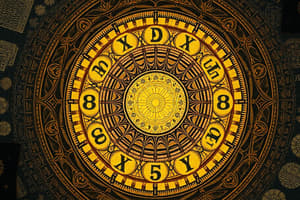Podcast
Questions and Answers
Which number system includes both rational and irrational numbers?
Which number system includes both rational and irrational numbers?
- Real Numbers (correct)
- Integers
- Complex Numbers
- Whole Numbers
Which of the following is an example of an irrational number?
Which of the following is an example of an irrational number?
- $\pi$ (correct)
- 0.333...
- $\sqrt{9}$
- $ rac{1}{2}$
What arithmetic operation is the inverse of exponents?
What arithmetic operation is the inverse of exponents?
- Roots (correct)
- Division
- Subtraction
- Multiplication
In algebra, what term is used to describe symbols that represent unknown quantities?
In algebra, what term is used to describe symbols that represent unknown quantities?
Which geometric transformation involves flipping a figure over a line?
Which geometric transformation involves flipping a figure over a line?
What concept in calculus describes the rate of change of a function?
What concept in calculus describes the rate of change of a function?
In statistics, which measure of central tendency represents the most frequent value in a data set?
In statistics, which measure of central tendency represents the most frequent value in a data set?
Which branch of mathematics deals primarily with shapes, sizes, relative positions of figures, and the properties of space?
Which branch of mathematics deals primarily with shapes, sizes, relative positions of figures, and the properties of space?
Flashcards
Natural Numbers
Natural Numbers
Counting numbers starting from 1: 1, 2, 3,...
Rational Numbers
Rational Numbers
Numbers that can be expressed as a fraction p/q, with integers p and q (q ≠ 0).
Irrational Numbers
Irrational Numbers
Numbers that cannot be expressed as fractions, like π and √2.
Algebraic Equation
Algebraic Equation
Signup and view all the flashcards
Polynomials
Polynomials
Signup and view all the flashcards
Derivative
Derivative
Signup and view all the flashcards
Geometric Transformations
Geometric Transformations
Signup and view all the flashcards
Measures of Central Tendency
Measures of Central Tendency
Signup and view all the flashcards
Study Notes
Fundamental Concepts
- Mathematics is a broad field encompassing various branches such as algebra, geometry, calculus, and statistics.
- It deals with abstract concepts like numbers, shapes, and logic to solve problems and model real-world phenomena.
- Mathematical concepts are fundamental to many other fields like science, engineering, and computer science.
Number Systems
- Natural numbers (counting numbers): 1, 2, 3,...
- Whole numbers: 0, 1, 2, 3,...
- Integers: ..., -3, -2, -1, 0, 1, 2, 3,...
- Rational numbers: numbers that can be expressed as a fraction p/q, where p and q are integers and q is not zero.
- Irrational numbers: numbers that cannot be expressed as a fraction. Examples include π (pi) and √2.
- Real numbers: the set of all rational and irrational numbers.
- Complex numbers: numbers that can be expressed in the form a + bi, where a and b are real numbers, and i is the imaginary unit (√-1).
Arithmetic Operations
- Addition (+): combining two or more quantities.
- Subtraction (-): finding the difference between two quantities.
- Multiplication (×): repeated addition.
- Division (÷): repeated subtraction or finding how many times one quantity is contained in another.
- Exponents: repeated multiplication.
- Roots (√): the inverse of exponents.
Algebra
- Variables: symbols that represent unknown quantities.
- Equations: statements that show the equality of expressions.
- Inequalities: statements that show the relationship between expressions (e.g., <, >, ≤, ≥).
- Polynomials: expressions consisting of variables and coefficients.
- Factoring: expressing a polynomial as a product of simpler expressions.
- Solving equations: finding the values of variables that make an equation true.
Geometry
- Shapes and figures: lines, angles, triangles, quadrilaterals, circles, and solids.
- Measurement: finding the length, area, volume of geometric figures.
- Transformations: reflections, rotations, translations, and dilations.
- Constructions: creating geometric figures using tools like a compass and straightedge.
Calculus
- Limits: the behavior of a function as its input approaches a specific value.
- Derivatives: the rate of change of a function.
- Integrals: the accumulation of a function over an interval.
- Applications: modelling physical phenomena using rates of change and accumulation.
Statistics
- Data collection and organization: collecting, classifying, and displaying data.
- Measures of central tendency: mean, median, and mode.
- Measures of dispersion: range, variance, and standard deviation.
- Probability: the likelihood of an event occurring.
- Statistical inference: drawing conclusions about a population based on a sample.
Logic
- Statements and propositions: declarative sentences that can be true or false.
- Connectives: and, or, not, if-then.
- Logical arguments: reasoning based on statements and connectives.
- Implications and deductions: drawing conclusions from given premises.
Studying That Suits You
Use AI to generate personalized quizzes and flashcards to suit your learning preferences.
Description
Explore the foundational concepts of mathematics including number systems and various mathematical branches such as algebra and geometry. This quiz covers key definitions and operations that are essential for understanding both abstract and practical applications of mathematics.




